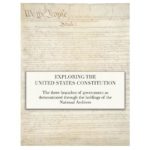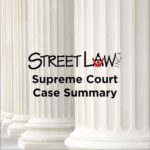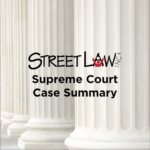This case summary provides teachers with everything they need to teach about Dred Scott v. Sandford (1857). It contains background information in the form of summaries and important vocabulary at three different reading levels, as well a review of relevant legal concepts, diagram of how the case moved through the court system, and summary of the decision. This resource also includes five classroom-ready activities that teach about the case using interactive methods. High school level also available.
HUD v. Rucker (2002)
Does HUD’s policy authorize a tenant to be evicted from public housing for the drug-related activity of a household member or guest? This case summary shows how the Supreme Court answered that question in 2002.
Missouri v. Seibert (2004)
Does an officer’s questioning prior to the recitation of a Miranda warning undermine the protection offered by the Fifth Amendment? This case summary shows how the Supreme Court answered that question in 2004.
Exploring the United States Constitution eBook

Each chapter connects one or more of the billions of primary source documents in the holdings of the National Archives to the principles found in the United States Constitution. These documents exemplify the workings of the three branches of the federal government as laid out in our Constitution. This eBook is available as a Multi-Touch book for iPad and Mac on iTunes, or for PC, Android devices, Mac, iPhone, iPad, or eReader with Scribd.
Rasul v. Bush (2004)
Twelve Angry Men: Trial by Jury as a Right and as a Political Institution
Twelve Angry Men, originally written for television by Reginald Rose in 1954 and subsequently adapted for stage (1955), film(1957) and television again (1997), effectively conveys the central importance of the right to a jury trial afforded by Article III of the Constitution as well as Amendments V, VI, and XIV.
Scottsboro Boys and To Kill a Mockingbird: Two Trials for the Classroom

In this lesson, students will perform a comparative close reading of select informational texts from the Scottsboro Boys trials alongside sections from To Kill a Mockingbird. Students analyze the two trials and the characters and arguments involved in them to see how fictional “truth” both mirrors and departs from the factual experience that inspired it.
U.S. v. Windsor (2013)
Constitutional Index – Amendment 5 Federal Due Process Clause
The Constitutional Index breaks down the U.S. Constitution by Section, Amendment, and Clause and contains broader topics and themes. These are used to cross-reference Library resources in an effort to annotate constitutional history.


